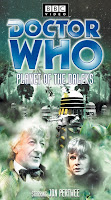
A powerful force from the universe of anti-matter has touched down on Earth, bringing a glutinous mass into being that terrorizes UNIT headquarters. The Doctor realizes that he alone cannot fight it and calls the Time Lords for help, but they themselves are being affected by a power drain and are unable to send anyone... except for the Doctor himself. The second Doctor, and then the first, are yanked from their respective time streams and sent to Earth to aid their third incarnation, but all end up transported through a black hole and into the anti-matter universe along with Jo, Benton, the Brigadier, innocent bystanders, Bessie, the TARDIS and the whole of the UNIT building. The culprit behind the power drain is a mythical figure (and indeed one of the Doctor's greatest heros) from the Time Lords' past: Omega, the stellar engineer who created the power source that drives the TARDIS and otehrs like it. Omega was thought dead when his ship was caught in the stellar detonation, but he was flung into the black hole it created and became anti-matter, and now he is ready to revenge himself upon the universe he feels abandoned him.
COOL I say. Damn COOL! Imagine being a fan in December 1972 and seeing Patrick Troughton reappear in the TARDIS in colour! And then William Hartnell shortly after! And then throw in massive amounts of background material on the home of the Doctor, and some of the mysteries that surround the Time Lords themselves.... fangasmic. Omega is by far one of the deadliest foes the Doctor has ever faced; as the ruler of his own universe his will is law, and the Doctor must physically fight the dark side of his mind to survive. And he's practically been driven mad in his solitude, creating lumpy blob creatures to do his bidding in his jewelled palace in the middle of nowhere. The fact that Omega wears a mask that is forged into a permenant frown is just the icing on the cake.
The Brigadier gets his first look inside the TARDIS after having it under his roof for the last three years, and he gets the shock of a lifetime coming face to face with the Doctor he first met during the Yeti crisis of the London Event, and then when the Cybermen invaded. "I didn't know when I was well off," he says upon realizing that there is another one as well, although due to a time eddy (and the fact that William Hartnell's health was deteriorating and he couldn't handle the studio sessions) he can do little more than advise from the TARDIS monitor. The TARDIS itself gets another facelift this story; the console room has a new configuation and even the exterior seems to have been given a fresh lick of paint, which is something Jay picked up on right away when it appeared in its luminous splendour.
Yes, Jay joined me once more for this classic adventure, and together we discussed the merits of the Doctor's people, the fact that his exile was going on for so long, the advancement of women's roles in Doctor Who (Jo is once more the only female in the adventure, and when not being coveted by the soldiers she is making coffee and standing by to catch the Doctor's cloak when he makes his dramatic entrances), and then we found our true source of hysteria: the TARDIS monitor screen. As William Hartnell's segments were recorded separately and played back over the monitor, there are close ups of it from within the studio, and relfected in the screen can be sen not just the assembled cast, but most of the studio and crew. The edge of the TARDIS set is clearly seen as are the cameras moving back and forth getting set for the next shot. We could even predict the movement of the characters by looking at the cameras as they set up for their next shots. Our last bit of wisdom came from the script itself; if you are a married woman in England in Doctor Who, it appears that you no longer have a name and are addressed as "woman" by your husband.
As the adventure is on DVD now, the clarity is absolutely brilliant, which impressed Jay no end, prompting him to observe that it looked like it had been shot yesterday. Mind you sometimes that sharp video image stuff looks like something off OMNI or Rogers, but who am I to judge.
Oh yes, and Jay makes an excellent cup of coffee. Green bits not withstanding.
So by the end of this adventure, we have so much more light cast on the Doctor's origins that it leaves us with even more questions, some of which will be answered in the years to come. And the Doctor's exile is lifted at last for his services to the Time Lords, leaving him free to travel once more...
NEXT EPISODE : CARNIVAL OF MONSTERS
Labels: Brigadier Lethbridge Stewart, Jo Grant, Omega, The 1st 2nd and 3rd Doctors, UNIT










